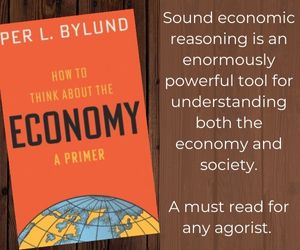
Savior in the Shadows: How the Free Market Helped to Collapse the Soviet Union and ‘Flatten the Curve’ of Suffering
Savior in the Shadows: How the Free Market Helped to Collapse the Soviet Union and ‘Flatten the Curve’ of Suffering
Free trade and open markets prop up producer and parasite alike. Do not be deceived. The issue is merely how long the parasitism will be tolerated. Communist mega powers throughout history, such as Soviet Russia, have structurally been destined to fail from the start. However, the final, lagging moments of desperate survival for these beasts often owes in some part to the long-suffering tolerance, adaptability, and survival instinct of free market forces.
Like a Begging Pal, but Deadly
It can be argued that the so-called ‘shadow economy’ of the Soviet Union (often referred to as the ‘second economy’) actually prolonged the collapse of the communist giant, even lending superficial credibility to the nation’s image for a brief flash of time. This is not to say parasitic forces like statist communism should be assisted in their survival — quite the contrary. It is only to point out the obvious: the rains fall on the just and unjust alike.The sun helps both weeds and flowers grow. An individual’s hard-earned wealth can similarly help both good and bad people around him.
We’ve all had that friend who borrows money without paying it back, for example. This person rarely has a dollar to spare, but even if they do, you know it ain’t coming back. On top of all this, they are often the first to note how ‘selfish you are being,’ that you shouldn’t be a fan of Ayn Rand’s work, or that your worldview is misguided, to the literally can’t even, fullest extent of sighing, pseudo-intellectual facepalm-ery.
Though the fruits of your labor have been shared to support them in this, their desperate time of lack, it doesn’t seem to register that it’s your selfish hard work and struggle — damn you, Ayn Rand — that made the giving possible. They’ll continue receiving from you until you simply cannot give anymore, and set a boundary. Meanwhile, out at the bar they’re a big spender for the time being, popular with their compatriots, as they loudly denigrate the evils of these ‘idiot libertarians.’ This is a pretty good image of how the relationship between individuals and governments work, minus the fact that your real life pal probably won’t murder you.
Soviet Russia’s Shadow Salvation: Illegal Markets
Due to the very nature of any shadow economy or illegal market, garnering accurate statistics and info about dealings therein is difficult or impossible. Still, according to scholarly sources, the impact of the Soviet second economy is agreed to have been quite massive — even elemental, among other major factors, in collapsing the empire. “There is no doubt that by the late 1970s, the Soviet second economy had grown to be fairly large relative to the first or the official economy,” details a Berkeley-Duke collaborative research paper on the topic.
“Professor [Gregory] Grossman has estimated that in the late 1970s, private income comprised between 28 and 33 percent of total household income.”
Thanks to the availability of private cash exchange in Soviet Russia for the common person (unlike government and high level, official transactions which had to be reviewed and approved by the state), even in the midst of economic oppression, goods not made available on legal markets could often be procured and privately provided via black market and shadow channels. Soviet narratives would demonize this emergent influence as corrosive to the social order, and ultimately harmful to the people, but these markets — for all their bad actors which exist in any market, and especially statist markets — provided much needed goods and services the government utterly failed to supply. Far beyond the drugs, sex, and violent services often associated with the term ‘black market’ today.
As noted by Encyclopædia Britannica’s Michael Ray:
By some measures, the Soviet economy was the world’s second largest in 1990, but shortages of consumer goods were routine and hoarding was commonplace. It was estimated that the Soviet black market economy was the equivalent of more than 10 percent of the country’s official GDP [some sources put this number at almost 40% in 1991]. Economic stagnation had hobbled the country for years, and the perestroika reforms only served to exacerbate the problem. Wage hikes were supported by printing money, fueling an inflationary spiral.
Individuals were not only turning to the shadow economy for ‘cheap thrills,’ in other words, but to secure their very survival and quality of life.
As Steven L. Sampson notes in his paper The Second Economy of the Soviet Union and Eastern Europe, “The second economies of the Soviet Union and other East European countries derive from structural inadequacies in the socialist planning system and from the cultural and historical evolution of each East European society.”
What the state could not or would not provide, or what they could not or would not provide sufficiently or adequately, the free market filled in as best it could. Appliance repair, illegal music recordings, produce and food, medicine, construction, drugs, prostitution, you name it. Prices may have been higher, but delivery times were often quicker. Lost time (read: ‘money’) standing in a breadline could justify and even balance out economically a higher price on speedier and more flexible shadow channels.
The top-down, obtuse planning of the centralized Soviet state could not read demand accurately, so critical bottlenecks occurred, either oversupplying goods where they were not needed, or undersupplying them where they were in high demand. Such incompetence encouraged pilfer and stealing from companies by workers, for their survival. Real distribution was done finally by the free market, illegally.
Though it was stymied and stifled at every turn, the shadow economy nonetheless helped to assuage the suffering and alleviate these bottlenecks. Central planners found out the hard way they couldn’t successfully set prices from Sears catalogues.
With actual demand being met increasingly by shadow channels, businesses reporting to central planners began to show their needs being fulfilled, which resulted in skewed allocation data. This further perpetuated the vicious cycle of mismanagement and lack of supplies, and moved real market action to the second economy, as the official economy steadily migrated toward the realm of mere ink and paper. As time went on, the two economies would diverge ever more drastically until the ultimate collapse of the Soviet Union in 1991.
Flattening the Curve of Socialist Suffering
In our current context of the first rumblings of supply chain disruption and rationing of food in the U.S., thanks to the manufactured hysteria surrounding a supposedly mild coronavirus, it’s haunting to look back at Soviet Russia now. The New York Times described in a 1982 article on the subject:
At noontime one day last week the meat counter was down to pitiful cuts of beef and mutton, mostly fat and bone. After a few weeks late last year when it disappeared from Moscow shops, butter was on sale again, but with a limit of 1.1 pounds per shopper. The vegetable counter boasted symmetrically arranged displays of carrots, beetroot and cabbage, but much of it was rotten.
Detailing the nightmare scenario further, Andrew Moran writes for Mises Wire:
…some cities had coupons, others imposed restrictions. To understand just how bad the food shortage was, state zoos made their animals become vegetarians. These developments soon shifted into other areas of the Iron Curtain, including healthcare. Children could not purchase milk without a doctor’s prescription, hospital power outages were routine, and the government initiated a public awareness campaign about the dangers of overeating. Medical bureaucrats used anesthesia as a form of extortion; it was “unavailable” for surgeries, but if you paid a bribe, then it magically appeared. The infant mortality rate was so bad that the government did not count children as being born until they survived their first month.
The staggering 62,000,000 lives claimed by Soviet rule from 1917 to 1987 — not counting external war — is likely underestimated, when far reaching and hard to track consequences of economic fallout are considered. The inherent ‘mercy’ of the free market is exemplified by the illegal products, services, and voluntary relationships between individual actors that rose to the occasion to provide survival and quality of life to those who would have otherwise suffered much more, had the devastating ‘curve’ of socialism not been flattened during its inevitable collapse.
While the shadow economy has been estimated to account for 10% to almost half of Soviet Russia’s GDP — depending on the time period and research methodology — what is clear is that it was an elemental force in bringing the legs out from under the communist table.
“In commerce, the second economy is pervasive,” Sampson’s 1987 study notes, “O’Hearn’s analysis of Soviet press reports indicates that 80-85 percent of all gasoline ends up on the black market, 25 percent of the internal fish catch is poached from state lands, 25 percent of all distilled alcohol is produced and sold outside the state sector.”
He continues: “Soviet emigre interviews suggest that 18 percent of all consumption expenditures were given to private individuals and that 30 percent of all home food was purchased outside the public sector or via connections … a Moscow survey showed that 70 percent of house repairs were carried out privately, most of this by illegal or unregistered repairmen. In Georgia from 97 to 99 percent of repairs to home and household items were done privately.”
Had these providers, communities, families, private traders, goods and services not existed, the suffering brought on by central planning would have been even more devastating. The Soviet state would have arguably fallen much more abruptly, as well. As the late agorist dynamo Samuel Konkin has noted in his speeches, the agoristic second economy at one point became so powerful that even state officials were forced to tacitly accept it, attempting to retroactively license illegal repair shops, while pretending to still be in control, to save face.
The rain falls on the just and unjust alike. Politics, military entanglements, societal changes, and nuclear disaster all ostensibly contributed to the final death rattle of the Soviet Union, but the emergence of the shadow economy in response to economic oppression is an oft-overlooked, central factor.
The sun shines on good and evil. Free markets will always fill the gaps left by centrally planned, incompetent states. Central planners will always try to take credit for this gap filling — much as the U.S. government has done on the backs of countless entrepreneurs, innovators and other hard working individuals who solidified the country’s reputation as a land of freedom, prosperity, and opportunity. When the idiotic central planning inevitably falters and fails, the state will always blame the free marketeers it depends on, and try to usurp and co-opt their business. As a parasitic entity, there is nothing else government can do.
It’s up to us to decide when to stop loaning out our talent and labor for free. Your friend may not pay you back, but he’s unlikely to kill you if you don’t pay up and just say ‘no.’ The state, on the other hand, knows no such humanity. Even so, free trade amongst agorists is necessary for any change to occur — in fact, it is the change. The non-politicized disobedience of non-compliant market actors everywhere remains the peaceful force with real, time-tested, and concrete potential to collapse empires.









